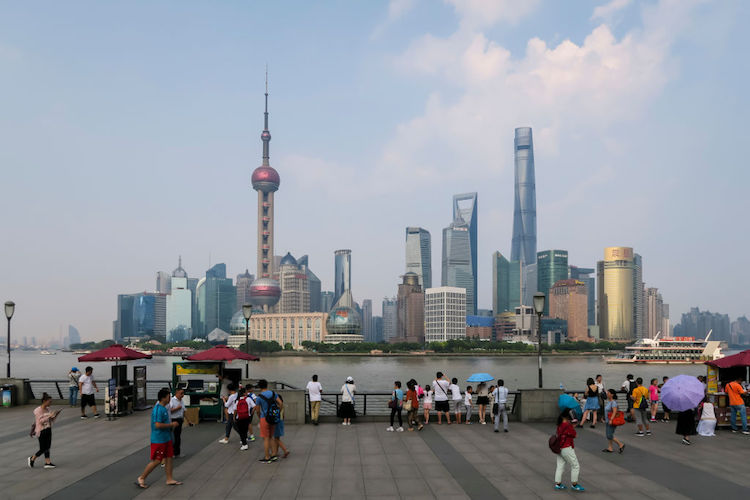| Above: Delfino Villagomez drinks water while laying asphalt on Thursday, July 20, 2017, in Omaha, Neb. Temperatures hit 98°F in Omaha on Thursday after a morning low of 80°F. Image credit: Kent Sievers/Omaha World-Herald via AP. |
Although this week’s heat wave across the central and eastern U.S. has fallen short of record-smashing in most areas, it’s managed to bring misery to tens of millions of people. Excessive heat warnings were in place on Friday for Omaha, Kansas City, Des Moines, St. Louis, and neighboring areas, where heat indices will range between 105°F and 115°F. The Philadelphia area was also in an excessive heat warning for heat indices that could reach 103°F. Heat advisories covered a vast swath of the central U.S. and the mid-Atlantic region.
The prevailing stagnant air mass is leading to widespread poor air quality, especially in the big cities of the East where low-level ozone is a major problem during heat waves. Air quality alerts were in effect Friday for the Atlanta region, central North Carolina, and most of the megalopolis from Washington, D.C., to New York. The Air Quality Index was predicted to reach the “unhealthy for sensitive groups” range across these areas on Friday, mainly due to ozone.
Meanwhile, most of central California is under an air quality alert for particulate pollution generated by ongoing forest fires, including the Detwiler Fire west of Yosemite. CalFire reported on Friday morning that the Detwiler fire had expanded to 74,083 acres and was just 15% contained.
As of July 21, we are squarely in the four-week period from early July to early August when most parts of North America typically notch their hottest readings of the year (see Figure 1 below). Yet with a few exceptions, the actual high temperatures in the last few days haven’t been too impressive by historical standards.
 |
| Figure 1. The average date of the highest temperature of the year across North America. Parts of the Southwest tend to peak just after the summer solstice, before arrival of the North American Monsoon, while it usually takes till August for air streaming into the Southern Plains from the Gulf of Mexico to hit its warmest point of the year. Image credit: Brian Brettschneider. |
The U.S. Records site maintained by NOAA/NCEI shows that 591 daily record highs and 79 record lows were notched from July 1 to July 13 (the last date for which data was available). That’s a fairly modest number when you consider that the first half of the year racked up 17,519 daily record highs and 4314 record lows, culminating in the great Southwest heat wave of June 2017.
Nevertheless, you don’t have to break heat records to feel uncomfortable in July. Thursday brought classic dog-day weather to much of the country, as documented in meteorologist Guy Walton’s frequently updated summer heat diary. Readings topped 100°F from Texas to Montana, and 90°-100°F temperatures (with ample humidity) slathered much of the populous Eastern Corridor from Georgia to Massachusetts. A noteworthy bubble of more intense heat pushed across the High Plains earlier this week. Boulder, CO, hit 100°F for the first time in 5 years on Wednesday, and Valentine, NE, hit 112°F on both Wednesday and Thursday. In 118 years of recordkeeping, only two other days have been hotter in Valentine.
Just north of the central U.S. heat core, a wavy frontal zone has played host to multiple rounds of intense thunderstorms over the last few days. The heavy rains have set the stage for flooding that could be locally significant along a broad zone from roughly Minneapolis to Chicago. Yet another round of evening and overnight storms is expected to roll through late Friday into Saturday. The NOAA/NWS Storm Prediction Center has an enhanced risk of severe weather in place for Friday, and there is a moderate risk of excessive rainfall across the region, with local amounts as high as 6” possible atop widespread 2” – 6” amounts over the past week. Several record flood crests were recorded on July 11-12 over far northern Illinois and southeastern Wisconsin.
 |
| Figure 2. Umbrellas help people beat the heat on Shanghai’s waterfront on Friday, July 21, 2017, when the city set an all-time high temperature record of 40.9°C (105.6°F). Image credit: STR/AFP/Getty Images. |
Hottest day in Shanghai’s history
Shanghai, China—with 24 million residents, the world’s largest city proper—had its hottest day ever recorded on Friday. Temperatures reached a preliminary high of 40.9°C (105.6°F) at the Xujiahui station in Shanghai, where temperatures have been monitored since 1872. The previous record high was 40.8°C, recorded in 2013, with the runner-up of 40.6°C also occurring that year. Much of China has been roasting in unusually hot weather this month, noted phys.org. Lows in Shanghai have failed to drop below 80°F for more than a week, and heat indexes have been averaging 110°-120°F.
Temperatures could match or exceed the all-time high yet again in Shanghai before a relative cooldown arrives by the middle of next week.
According to insurance broker Aon Benfield, portions of China’s Northeast, North China Plain, and Loess Plateau provinces (well north of Shanghai) were pounded by severe thunderstorms from July 13 - 17, causing flooding, wind, and hail damage that killed 38 people and cost over $3.4 billion.




